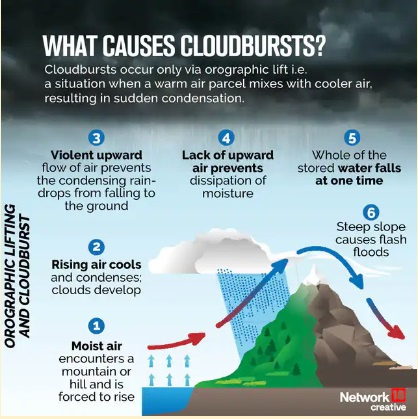- Courses
- GS Full Course 1 Year
- GS Full Course 2 Year
- GS Full Course 3 Year
- GS Full Course Till Selection
- Answer Alpha: Mains 2025 Mentorship
- MEP (Mains Enrichment Programme) Data, Facts
- Essay Target – 150+ Marks
- Online Program
- GS Recorded Course
- Polity
- Geography
- Economy
- Ancient, Medieval and Art & Culture AMAC
- Modern India, Post Independence & World History
- Environment
- Governance
- Science & Technology
- International Relations and Internal Security
- Disaster Management
- Ethics
- NCERT Current Affairs
- Indian Society and Social Issue
- NCERT- Science and Technology
- NCERT - Geography
- NCERT - Ancient History
- NCERT- World History
- NCERT Modern History
- CSAT
- 5 LAYERED ARJUNA Mentorship
- Public Administration Optional
- ABOUT US
- OUR TOPPERS
- TEST SERIES
- FREE STUDY MATERIAL
- VIDEOS
- CONTACT US
Cloudbursts in Himachal Pradesh
Cloudbursts in Himachal Pradesh
04-08-2024
Recently, a cloudburst occurred in Himachal Pradesh, a state in northern India. This cloudburst led to flash floods, which caused many deaths and left several people missing.
- The floods also destroyed many buildings, bridges, and roads, according to officials.
What is a Cloudburst?

- Definition: A cloudburst is a sudden and heavy rainstorm that drops a lot of rain in a short time over a small area. The India Meteorological Department (IMD) says that a cloudburst brings more than 10 centimeters (about 4 inches) of rain in less than an hour over an area of about 10 square kilometers (about 4 square miles).
- Where it happens: Cloudbursts often happen in mountainous areas, especially in the Himalayas. In the Indian Subcontinent, cloudbursts generally occur when a monsoon cloud moves northwards from the Bay of Bengal or the Arabian Sea, across the plains, and then onto the Himalayas. This can bring about 75 millimeters (about 3 inches) of rain per hour.
- Causes: Cloudbursts occur when strong upward currents of hot air prevent raindrops from falling immediately. This allows the raindrops to grow larger while new, smaller drops form below. As a result, a significant amount of water accumulates in the atmosphere and is released abruptly when the upward currents weaken. The complex topography of the hilly and mountainous areas in the Indian subcontinent helps this process, known as orographic lifting. This occurs when air rises and cools as it travels up the windward side of a mountain, enhancing cloud development and rainfall. Monsoon dynamics and local weather patterns also influence these intense rainfall events.
Cloudburst vs Rainfall:
- Rainfall: Rain is condensed water that falls from a cloud. It can be light, moderate, or heavy, and it usually happens over a larger area and for a longer duration than a cloudburst.
- Cloudburst: A cloudburst is a sudden, heavy rainstorm that brings a lot of rain in a short time over a small area. Rainfall over 10 centimeters (about 4 inches) per hour is categorized as a cloudburst. Cloudbursts are natural phenomena, but they occur quite unexpectedly, very abruptly, and can be very drenching.
Prediction:
- Challenges: There is no satisfactory technique for anticipating the occurrence of cloudbursts through satellites and ground monitoring stations. This is because cloudbursts develop over a small area and for a short period. To detect the likelihood of a cloudburst, a very fine network of radars is required, which would be expensive.
- Current capabilities: At present, only the areas likely to receive heavy rainfall can be identified on a short-range scale. Much of the damage caused by cloudbursts can be avoided by identifying the areas and the meteorological situations that favor their occurrence.
Examples of Cloudbursts:
- Uttarakhand Cloudburst (July 2021): In July 2021, devastating cloudbursts occurred in the districts of Chamoli, Uttarkashi, and Pithoragarh in the state of Uttarakhand, India. These cloudbursts caused flash floods, landslides, and extensive damage to infrastructure and lives.
- Himachal Pradesh Cloudburst (August 2020): In August 2020, cloudbursts in the districts of Kullu, Lahaul-Spiti, and Kinnaur in Himachal Pradesh triggered landslides and flash floods. These events damaged roads, bridges, and houses, causing significant destruction.
Consequences of Cloudbursts:
- Flash Floods: Flash floods are sudden, localized surges in water levels during or after intense rainfall. They can start within 6 hours or even as quickly as 3 hours of heavy rainfall. Flash flooding is typically caused by intense thunderstorms but can also result from dam or levee breaks and mudslides. Factors like rainfall intensity, location, land use, topography, vegetation, soil type, and water content determine the speed and location of flash flooding.
- Landslides: A landslide is a mass movement of material, such as rock, earth, or debris, down a slope. Landslides can happen suddenly or more slowly over long periods. Factors like heavy rainfall, erosion, and weathering can trigger landslides. In India, landslides account for about 8% of global fatalities, with 847 deaths and thousands displaced from 2001 to 2021, according to research from IIT-Madras. Around 13.17% of India's area is susceptible to landslides, with 4.75% designated as "very highly susceptible." Sikkim is the most prone state, while Kerala has over 14% of its land in the very high susceptibility category.
- Mudflows: Mudflows are a type of water flow characterized by their high density and viscosity, containing significant amounts of suspended particles and silt. Mudflows can only transport and deposit the coarsest materials, leading to irreversible sediment entrainment. They typically do not flow as far as regular water streams.
Impact of Climate Change on Cloudbursts:
- Increased Atmospheric Moisture: Rising global temperatures allow the atmosphere to hold more moisture. This moisture-laden air can lead to more intense cloud formation and increased potential for cloudbursts, especially in mountainous areas like the Himalayas.
- Changes in Precipitation Patterns: Climate change can shift precipitation patterns, causing some regions to experience prolonged dry periods while others face more intense rainfall events.
- Altered Atmospheric Stability: Higher temperatures can destabilize the atmosphere, leading to increased convective activity and more frequent thunderstorms, which are often linked to cloudbursts.
- Glacier Retreat and Snowmelt: Melting glaciers in regions like the Himalayas, driven by rising temperatures, are releasing water more quickly. This can potentially contribute to cloudburst events.
- Land Use Changes: Human activities such as deforestation and urbanization can alter local climates and precipitation patterns. These changes affect microclimates in mountainous areas and potentially influence cloudburst occurrences.
Ways to Mitigate the Devastating Impact of Cloudbursts:
- Early Warning Systems: Develop effective early warning systems to predict cloudbursts and provide timely alerts. This allows people to prepare and evacuate if necessary, reducing the risk of injury and death.
- Urban Planning and Infrastructure: Invest in resilient urban planning and infrastructure, such as stormwater drainage systems, retention ponds, and green spaces. These measures help manage excess water and reduce flooding, minimizing the damage caused by cloudbursts.
- Watershed Management: Implement practices to manage watersheds, like reducing soil erosion and increasing soil infiltration. These practices help control water flow and lessen the impact of cloudbursts, reducing the risk of flash floods and landslides.
- Reforestation and Green Infrastructure: Plant trees and maintain green areas to absorb excess water, reduce soil erosion, and stabilize slopes. These measures help mitigate the effects of cloudbursts, such as flash floods and landslides.
- Awareness and Education: Educate communities about the risks associated with cloudbursts and train them on response and evacuation procedures. Ensuring that people are aware of the dangers and know how to react can save lives and minimize damage.
- Sustainable Land Use Practices: Promote land use practices that reduce vulnerability to cloudbursts, such as avoiding construction in flood-prone areas, controlling deforestation, and implementing soil conservation measures. These practices help minimize the impact of cloudbursts on communities and the environment.
- International Cooperation: Work with neighboring countries and international organizations to share best practices, technology, and resources for managing cloudbursts, especially in shared river basins. International cooperation can help improve the effectiveness of mitigation strategies and reduce the overall impact of cloudbursts.
Conclusion:
Cloudbursts in Himachal Pradesh have caused significant damage, loss of life, and destruction of infrastructure. Implementing measures such as early warning systems, resilient infrastructure, watershed management, reforestation, awareness campaigns, sustainable land use practices, and international cooperation can help reduce the devastating effects of cloudbursts. By working together and taking proactive steps, communities and governments can better manage the risks associated with cloudbursts and protect lives and property.




